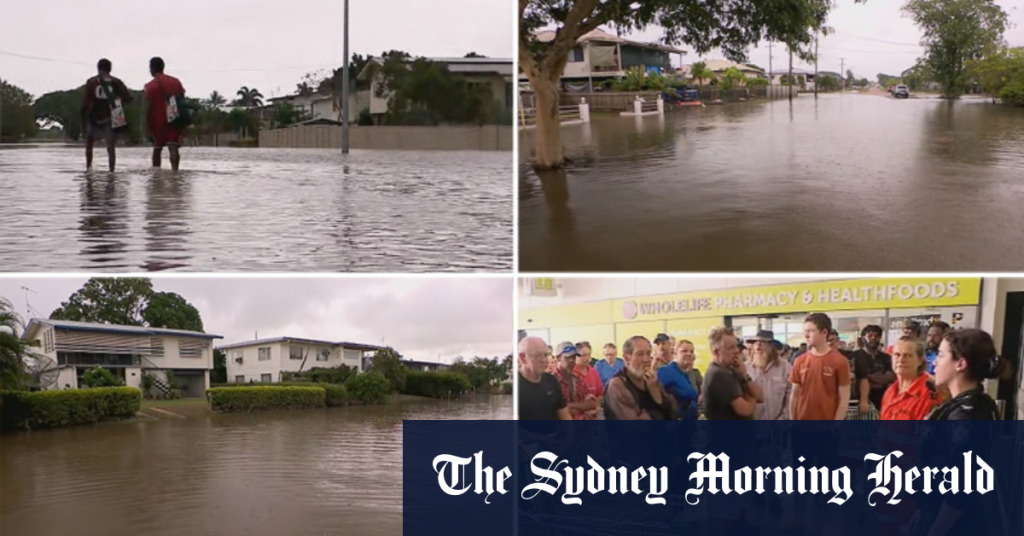The video news report depicts the initial stages of recovery in Queensland, Australia, following a significant flood event. Residents who had been previously evacuated are starting to return to their homes and communities, beginning the arduous process of assessing the damage and rebuilding their lives. The footage likely shows scenes of residents navigating streets still bearing the marks of the floodwaters, perhaps with debris piled up along the roadsides and homes displaying the telltale water lines marking the flood’s peak. The emotional toll is also likely visible, with residents expressing a mixture of relief at being able to return and the dawning realization of the challenging road ahead. The report probably includes interviews with residents describing their experiences during the evacuation and their immediate concerns, such as access to clean water, power restoration, and the availability of essential supplies.
As residents re-enter their towns, the scale of the damage becomes starkly apparent. Homes once filled with life are now often filled with mud and debris, requiring extensive cleaning and repairs. Businesses, also impacted by the floodwaters, face the daunting task of reopening, adding to the economic strain on the affected communities. The video likely showcases the collective effort underway to clean up the streets and restore essential services. Volunteer organizations and emergency services personnel are likely visible, providing assistance with debris removal, distributing supplies, and offering support to residents struggling to cope with the aftermath. The resilience of the community is highlighted as neighbors help neighbors, demonstrating the strength of human spirit in the face of adversity.
The initial return period is fraught with challenges. The report probably emphasizes the logistical difficulties of accessing flood-affected areas, as roads and infrastructure may still be damaged. The lack of basic amenities like electricity and clean water poses immediate health and safety concerns. The risk of further damage from lingering floodwaters or potential landslides remains a concern, requiring ongoing monitoring and precautionary measures. The emotional impact of the flood event, coupled with the daunting task of rebuilding, takes a toll on residents, highlighting the need for mental health support services. The video likely features interviews with government officials and representatives from aid organizations outlining the support measures available to residents and the long-term recovery plan for the affected areas.
The rebuilding process is only just beginning as residents return. The video likely underscores the long-term challenges ahead, from repairing damaged homes and businesses to restoring essential infrastructure. The financial burden of rebuilding will be substantial, requiring government assistance, insurance payouts, and community fundraising efforts. The report may showcase early recovery efforts, such as the distribution of building materials and the assessment of structural damage. The focus shifts from immediate relief to long-term recovery planning, highlighting the need for sustainable rebuilding practices to mitigate the impact of future flood events. The resilience of the community will be tested in the months and years to come as they work to rebuild their lives and their towns.
The flood event serves as a stark reminder of the increasing frequency and intensity of natural disasters, likely attributed to the impacts of climate change. The video may touch upon the broader implications of climate change and the need for proactive measures to mitigate future risks. Discussions about flood mitigation infrastructure, early warning systems, and community preparedness become crucial. The report might include expert opinions on climate change and its connection to extreme weather events, emphasizing the need for global action to address the root causes of climate change and reduce the vulnerability of communities to such disasters. The recovery process in Queensland becomes a microcosm of the global challenge of adapting to a changing climate and building more resilient communities.
Beyond the physical rebuilding, the recovery process also involves the emotional healing of the affected community. The video likely concludes by emphasizing the importance of community support and mental health services in the long term. The trauma of experiencing a flood event can have lasting effects, and access to counseling and support groups is essential for residents to cope with the emotional aftermath. The community spirit and resilience highlighted throughout the report become crucial elements in the long road to recovery, underscoring the power of human connection in overcoming adversity. The flood event, while devastating, also serves as a testament to the strength and resilience of the human spirit and the capacity of communities to rebuild and recover in the face of extraordinary challenges.










